

Creating Effective Collaborative Learning Groups in an Online Environment. Jane E. Brindley and Christine Walti University of Oldenburg, Germany Lisa M. Blaschke University of Maryland University College, USA Abstract Collaborative learning in an online classroom can take the form of discussion among the whole class or within smaller groups.
Academic group collaboration - Wiggio. Free Group Member Jennifer G, Student Favorite Feature: Group Member Veronica W, Student Group Member Colleen K, Student Group Member Alysia W, Student Group Member Darla D, Professor Group Member Mike R, Student Group Member Adam R, Student “The simplest way I've found to assign tasks to each member of the project team.
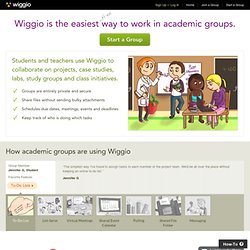
50 Fabulous Web Tools for Group Projects. JOLT - Journal of Online Learning and Teaching. Introduction It is generally agreed that learning involves interaction and that it is a communal activity (McMillan & Chavis, 1986; Sarason, 1974).

The traditional setting where communal learning activity occurs has been the in-person classroom; however, with the advent of technology that is no longer the case. While communities in general have been considered to be “place-based” (Paloff & Pratt, 1999, p. 21), the success of MySpace.Com and numerous other online communities demonstrate how communities can transcend physical spaces and still have actively engaged participants. The purpose of this survey research was to compare instructor and student perceptions about building community in online university classes. The paper begins by reviewing the literature which has linked community to the learning process and identified it as essential.
Literature Survey. 285. Tip60. Is your course meaningful to your students or are they just swimming through a pool of content?
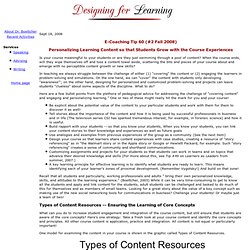
When the course ends, will they wipe themselves off and toss a content towel aside, scattering the bits and pieces of your course about and emerge with no perceptible content growth or new skills? In teaching we always struggle between the challenge of either (1) "covering" the content or (2) engaging the learners in problem-solving and simulations. On the one hand, we can "cover" the content with students only developing "awareness"'; on the other hand, designing for personalized and customized problem-solving and projects can leave students "clueless" about some aspects of the discipline. What to do? Here are a few bullet points from the plethora of pedagogical advice for addressing the challenge of "covering content" and engaging and personalizing learning.
" Be explicit about the potential value of the content to your particular students and work with them for them to discover it as well! Index. This library of tips addresses the many issues, challenges and fun in designing and teaching a course in blended or online environments.
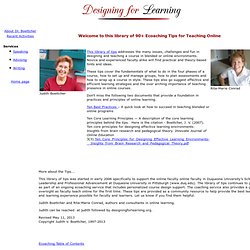
Novice and experienced faculty alike will find practical and theory-based hints and ideas. These tips cover the fundamentals of what to do in the four phases of a course, how to set up and manage groups, how to plan assessments and how to wrap up a course in style. These tips also go suggest effective and efficient learning strategies and the over arching importance of teaching presence in online courses. Don't miss the following two documents that provide a foundation in practices and principles of online learning. Ten Best Practices – A quick look at how to succeed in teaching blended or online programs. NACOLStandardsQualityOnlineTeaching. 10 online icebreakers. For the third time I was going through all my resources- files and bookmarks to find online icebreakers.
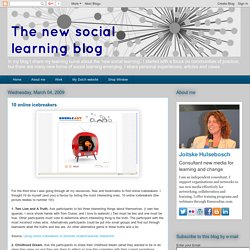
I thought I'd do myself (and you) a favour by listing the most interesting ones. 10 online icebreakers (the picture relates to number 10!) : 1. Two Lies and A Truth. Ask participants to list three interesting things about themselves. Source: Using online icebreakers to promote student/teacher interaction 2. 3. 4. Source: Nancy White’s online facilitation course. 5. Source: CPsquare’s foundations of communities of practice online course. 6. Source: Trading cards 7. Source: Dorine Ruter, ecollaboration list. 8. Help Students Say Something Substantial. What Constitutes a Substantial Posting?
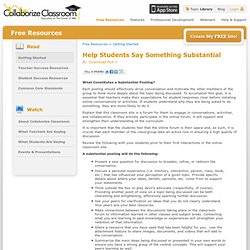
Each posting should effectively drive conversation and motivate the other members of the group to think more deeply about the topic being discussed. To accomplish this goal, it is essential that teachers make their expectations for student responses clear before initiating online conversations or activities. If students understand why they are being asked to do something, they are more likely to do it.
Explain that this classroom site is a forum for them to engage in conversations, activities, and collaboration. If they actively participate in the online forum, it will support and strengthen their understanding of the curriculum. It is important that the students feel that the online forum is their space and, as such, it is crucial that each member of the class/group take an active role in ensuring a high quality of discussion. Starbursting Template. Peer Learning Handbook.
On how #edcmooc did a cmooc on Coursera. By demonstrating that you could build a very “open” course on Coursera, the University of Edinburgh team in charge of E-learning and Digital Cultures succeeded in breaking down some walls between the large-scale free course (called xMOOC by some critics) and the cMOOC connectivist learn-fest.
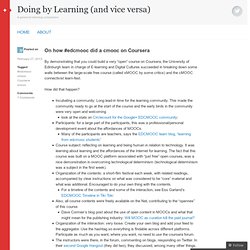
How did that happen? Incubating a community: Long lead-in time for the learning community.